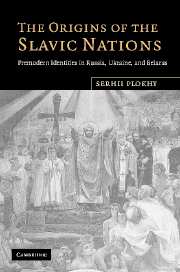Book contents
- Frontmatter
- Contents
- Preface
- Note on transliteration, dates, and translations
- Maps
- Introduction
- 1 The origins of Rus′
- 2 What happened to the Rus′ Land?
- 3 The Lithuanian solution
- 4 The rise of Muscovy
- 5 The making of the Ruthenian nation
- 6 Was there a reunification?
- 7 The invention of Russia
- 8 Ruthenia, Little Russia, Ukraine
- Conclusions
- Author index
- General index
5 - The making of the Ruthenian nation
Published online by Cambridge University Press: 25 July 2009
- Frontmatter
- Contents
- Preface
- Note on transliteration, dates, and translations
- Maps
- Introduction
- 1 The origins of Rus′
- 2 What happened to the Rus′ Land?
- 3 The Lithuanian solution
- 4 The rise of Muscovy
- 5 The making of the Ruthenian nation
- 6 Was there a reunification?
- 7 The invention of Russia
- 8 Ruthenia, Little Russia, Ukraine
- Conclusions
- Author index
- General index
Summary
The late sixteenth and early seventeenth centuries or, more precisely, the eight decades between the Union of Lublin (1569) and the beginning of the Khmelnytsky Uprising (1648) are often treated as a distinct period in the history of Poland, Lithuania, Ukraine, and Belarus. If the starting point requires little introduction, since it was marked by the creation of the Polish-Lithuanian Commonwealth, the terminus certainly needs some explanation. The Cossack uprising of 1648, led by Hetman Bohdan Khmelnytsky, spread to most of the Ukrainian territories and took in a significant part of the Belarusian lands. More than previous Cossack revolts, it shook the Commonwealth, resulting in the loss of much of its territory and inaugurating a long series of wars that eventually led to the decline of the Polish-Lithuanian state. The uprising also marked the end of Polish-Lithuanian eastward expansion and set off a long Muscovite drive to the West that saw Russian troops enter Paris in 1813 and the Red Army occupy Berlin in 1945. More immediately important for our discussion is that the uprising brought about the first prolonged encounter between Muscovite and Polish-Lithuanian Rus′, which led to their political union. The Khmelnytsky Uprising and its long-term consequences must be viewed as a result of the interaction of various political, social, religious, and cultural factors that were not in place in 1569. The same period saw the formation of a new type of identity that was to have an important effect on subsequent developments.
- Type
- Chapter
- Information
- The Origins of the Slavic NationsPremodern Identities in Russia, Ukraine, and Belarus, pp. 161 - 202Publisher: Cambridge University PressPrint publication year: 2006
- 1
- Cited by



